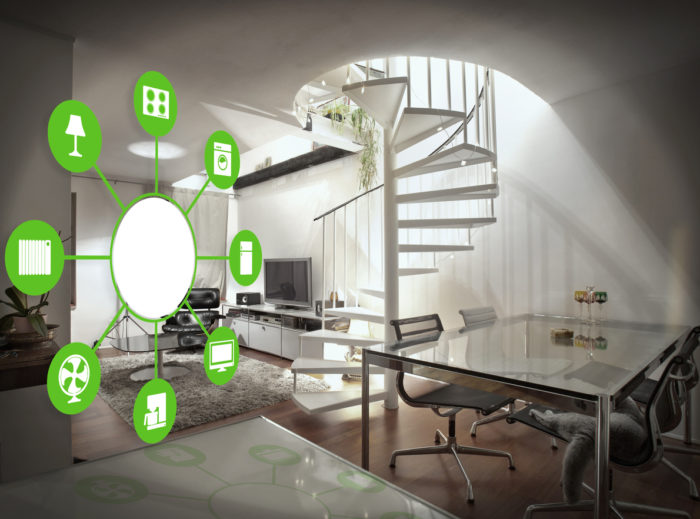With about two billion do-this, do-that and do-the-other gadgets gaining space in big-box stores and online shopping carts – and another seven billion expected to flood the market by 2018 – it is safe to say smart-home devices have hit their stride.
The numbers nearly outpace the plethora of cellphones on the planet, if that is possible. Everyone has an Android or an iPhone, and now everyone will have an app-controlled piece of electronic equipment in the family home.
“From the watch on our wrist to the thermostat on our wall, what were previously inanimate objects are being brought to life through technology,” according to a study by Acquity Group titled “The Future of Consumer Adoption of The Internet of Things.” “Wearable devices are going to become a larger part of our everyday lives, influencing our mannerisms, interactions, health and likely fashion. With crowdfunding, investors and giants like AT&T, Apple and Google pouring millions into the connected devices industry, there will be plenty of opportunity to begin managing a digital home. This tech offers enormous growth potential.”
The study was published in 2014, and most of its predictions have come true. From watches to wellness trackers, from laundry to lights to locks and from alarms alerting users to home-security issues to music playing on wireless speakers via simple voice commands, the list of smart devices is long. It also is laborious.
“If we all agree that our house plays a key element in the well-known Maslow’s hierarchy of needs, it is logical to think that we can not resist the temptation to introduce smart home automation systems to improve our lives with more security, comfort, control and entertainment,” writes blogger Paco Maroto in an entry titled “The Dangers of Too Smart Homes.” “And that´s fantastic if we do not convert our life in a hell because of the amount of devices and technology that we installed on our home sweet home.”
How many smart-home devices one needs is something to consider prior to plopping down hard-earned dollars on Alexa, Google Home, Nest, Philips Hue, Samsung SmartThings and so on. Why? Because there is a bad side to smart-home devices and the likelihood that something probably will go wrong.
Writes Stacey Higginbotham in a Fortune article titled “5 reasons why the ‘smart home’ is still stupid,” “For several days after I returned from my vacation, the lights in my house would automatically turn on around 6 pm and then again at 7 am. This would have been far more frustrating in the morning if it weren’t already light and we weren’t mostly up anyway. But there were a few times when my husband rolled over and seriously questioned my commitment to smart home technology….”
Higginbotham researched the reason for the automatic turn-ons and shut-downs and learned the “smart” part of the home device “decided” 6 p.m. and 7 a.m. were a schedule for her household.
“These stories illustrate some of the problems that smart home technology has yet to solve, even three years after some of them were first mentioned,” she writes. “They also show why having a truly smart and intuitive home is still the stuff of science fiction (or very expensive programmers).
The HAL 9000 character in Stanley Kubrick’s 2001: A Space Odyssey comes to mind. Hal’s artificial intelligence in the then-futuristic film tries to take over the astronauts’ ship and threatens their lives. Here is the infamous exchange.
Dave: “Open the pod bay doors, HAL.”
HAL: “I’m sorry, Dave. I’m afraid I can’t do that.”
Dave: What’s the problem?
HAL: I think you know what the problem is just as well as I do.
Dave: What are you talking about, HAL?
HAL: This mission is too important for me to allow you to jeopardize it.
Dave: I don’t know what you’re talking about, HAL.
HAL: I know that you and Frank were planning to disconnect me, and I’m afraid that’s something I cannot allow to happen.
Dave: [feigning ignorance] Where the hell did you get that idea, HAL?
HAL: Dave, although you took very thorough precautions in the pod against my hearing you, I could see your lips move.
While a middle ground exists between lights switching on and off at will and the risk of death by a crazy computer, the circumstances still are bad. Codes, passwords and user names can be obtained by hackers who tap into the Internet of Things. Security can be compromised in the home a smart device is supposed to make safe. And identities can be stolen in cases of connected retail. Consumers should stay as smart or as smarter as their smart-home devices.
“…Security issues remain a valid and frightening concern,” Shifrah Combiths writes on the Apartment Therapy Web site in an article titled “The Good, the Bad & the Ridiculous: The Future of Life at Home.” “We’ve all been horrified by the hacked nanny cams used to gain eyes into the intimate rooms of our homes. Many savvy technophiles are waiting until another generation of smart home products, ones with less permeable boundaries, comes out before opting into the system.”
So, if you cannot open your smart home front door, the worry is….can someone else now open it?
Share This



